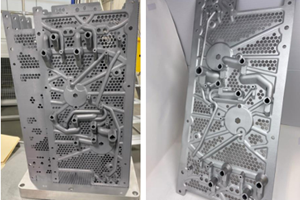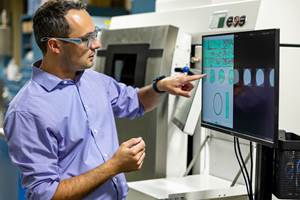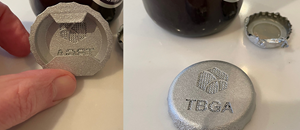Dyndrite Joins ASTM to Provide AM Reference Data
Collaborative effort aims to create shareable reference datasets that drive consistency across the industry, accelerating qualification and adoption of metal additive manufacturing.
Share
Dyndrite has joined the ASTM International Consortium for Materials Data and Standardization (CMDS) initiative which is being run through the ASTM Additive Manufacturing Center of Excellence (AM CoE). The collaborative effort is designed to create shareable reference datasets that can help drive consistency across the industry, helping to accelerating qualification and adoption of metal AM.
Dyndrite is a provider of the GPU-accelerated computation engine used to create next-generation digital manufacturing hardware and software. The company will collaborate with industry members chartered to standardize the requirements for AM materials data generation, and create and manage shared high-pedigree reference datasets.
The company will create shareable standardized designs-of-experiments (DoE) build recipes across all major L-PBF OEM file formats. Dyndrite joins existing members such as AddUp, Auburn University, Boeing, Desktop Metal, EOS, Fraunhofer IAPT, GE Additive, GKN Additive and others.
“Dyndrite believes standardization is a crucial next step in the broader adoption and growth of industrial AM,” says Stephen Anderson, Dyndrite head of strategic relationships. “Whoever we talk to, the clarion call is clear. Our customers and partners all want to see significant acceleration of shared materials data to unlock new AM opportunities and to scale the industry. This is a groundbreaking opportunity to unleash the full power of metal 3D printing.”
To date, individual companies have singularly borne the brunt of materials development costs and regard their results as proprietary for commercial advantage. But this leads to multiple companies wasting dollars with each repetitively doing the same thing. CMDS’ work will help solve these problems by enabling the sharing of materials data at a fundamental level, while still enabling companies to generate IP and differentiate on specific geometry parameter modification.
Dyndrite recently unveiled its first end-user AM application, Dyndrite Materials and Process Development for laser bed powder fusion (LPBF). This GPU-based 3D application was designed for materials and process engineers developing new metal alloys and parts for laser-based 3D metal printing. It takes advantage of the features within Dyndrite’s Accelerated Computation Engine (ACE), including the ability to perform 3D geometric queries in order to detect and optimize for difficult geometric features such as domes, cantilevers, and thin walls. It also offers the ability to speed build rates by easily working with large multiple layer heights and print rates; methods to improve part quality by ensuring material homogeneity and controlling surface roughness; and support strategies said to delivery maximum flexibility. Customers using Dyndrite can also easily create shareable build recipes (Python) that provide all the necessary information required to recreate a build and drive a variety of 3D metal printers, including Aconity, EOS, Renishaw, SLM and others.
“We are pleased that Dyndrite has decided to join the CMDS initiative and prioritize the need to standardize the data workflows needed to generate high-pedigree material data,” says Richard Huff, ASTM director of industry consortia and partnerships. “We are excited to integrate Dyndrite’s solutions to drive consistent application of requirements and maximize efficiency of CMDS data generation activities.”
Dyndrite says it has built tools capable of ensuring quality and traceability through AM component production. “This is increasingly important as the metal AM industry moves to generate foundational material data built upon the Common Data Model,” says Steve Walton, Dyndrite head of product. “Our work enables knowledge transfer of critical material data and pedigree needed for robust characterization of the process-structure-property relationship. Understanding and effectively communicating this concept will greatly increase the adoption of metal AM for production applications.”
Dyndrite will release build recipes that demonstrate how standardized designs-of-experiments (DoE) — based on ASTM data standards — can be made using Dyndrite. ASTM members will be able to use these recipes, or make their own, across all major OEM file formats. These recipes will enable a common framework for build file generation, scan-path strategy exploration and scan-path speed and layer thickness variation, as well as methods for estimating laser(s) loads. By conforming to ASTM data protocols Dyndrite Build recipes will ensure that data is generated and recorded in a standard and repeatable manner, and applicable to downstream processes, such as process qualification and calibration.
- Read how Dyndrite and UPM are working to bring data intelligence to metal 3D printing build plates. The collaboration aims to reduce print failures and enable reliable supply chain for additive manufacturing production.
- Learn about Dyndrite’s collaboration with AMFG for cross-platform 3D metal automated production. AMFG powered by Dyndrite is an integrated solution that is said to unlock the full potential of metal 3D printing by bringing order-to-part automation, eliminating bottlenecks and streamlining the entire production process for increased efficiency and cost savings.
Related Content
Additive Manufacturing in Transportation: How It Moves Us
Transportation is experiencing unprecedented pressure to move people and goods farther, faster, cheaper and more sustainably. The Barnes Global Advisors and Wabtec discuss the role that additive manufacturing is playing for rail transportation, and how 3D printed parts such as manifolds are qualified for this industry.
Read MoreInspection Method to Increase Confidence in Laser Powder Bed Fusion
Researchers developed a machine learning framework for identifying flaws in 3D printed products using sensor data gathered simultaneously with production, saving time and money while maintaining comparable accuracy to traditional post-inspection. The approach, developed in partnership with aerospace and defense company RTX, utilizes a machine learning algorithm trained on CT scans to identify flaws in printed products.
Read MoreVelo3D Founder on the 3 Biggest Challenges of 3D Printing Metal Parts
Velo3D CEO and founder Benny Buller offers this perspective on cost, qualification and ease of development as they apply to the progress of AM adoption in the future.
Read MoreA Framework for Qualifying Additively Manufactured Parts
A framework developed by The Barnes Global Advisors illustrates considerations and steps for qualifying additively manufactured parts, using an example familiar to those in AM: the 3D printed bottle opener.
Read MoreRead Next
At General Atomics, Do Unmanned Aerial Systems Reveal the Future of Aircraft Manufacturing?
The maker of the Predator and SkyGuardian remote aircraft can implement additive manufacturing more rapidly and widely than the makers of other types of planes. The role of 3D printing in current and future UAS components hints at how far AM can go to save cost and time in aircraft production and design.
Read MoreHybrid Additive Manufacturing Machine Tools Continue to Make Gains (Includes Video)
The hybrid machine tool is an idea that continues to advance. Two important developments of recent years expand the possibilities for this platform.
Read More3D Printing Brings Sustainability, Accessibility to Glass Manufacturing
Australian startup Maple Glass Printing has developed a process for extruding glass into artwork, lab implements and architectural elements. Along the way, the company has also found more efficient ways of recycling this material.
Read More






















